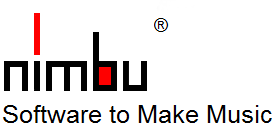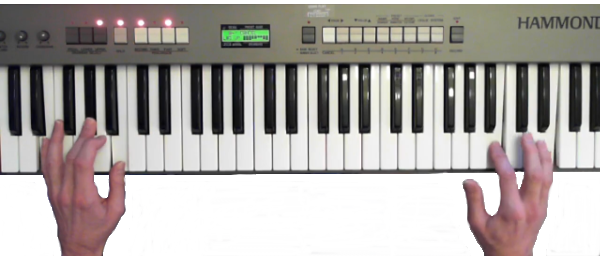Making music that captivates
We illustrate basics and operation in the form of YouTube® videos and SoundCloud® audio files that we link to.
From nimbu 6.40 we create new videos in Full HD. The first video is Video 1, which we recommend as an introduction and overview. Further explanatory videos will follow.
Video 1: A new Dimesion in Auto Accompaniment
This demo video gives an overview of the integrated editing, control and playing options in nimbu, which are demonstrated and explained using musical examples. The additional tensions lend nimbu the authentic sound of a band. Even with single-finger automatic.
Here are some older video and audio examples.
Video A: Playing in free improvisation
Gordian Wittenbecher (gordianmusic.de) plays his interpretation of the Las Ketchup song here. We show how this accompaniment is created in video C This accompaniment plays characteristic lines in some places, which are even used for improvising.
Video B: How to use MIDI files to create high-quality, title-related accompaniments - Example 1
Here an accompaniment is calculated from a MIDI file, which is played with automatic accompaniment. In this case, one piano moves fully in the harmony by playing only chord tones, while at the same time another piano plays additional tension tones. Since nimbu transposes chord scales composed of chord tones and tension tones, this is not a problem.
Video C: How to use MIDI files to create high-quality, title-related accompaniments - Example 2
Here a further accompaniment is calculated from a MIDI file. Exactly this accompaniment is played in video A a few semitone steps shifted.
Video D: Loading Keyboard Styles
This video shows how keyboard styles are loaded into nimbu and played with single-finger automatic. The actual loading requires only four mouse clicks. There are thousands of these styles on the internet for free. From this pool of styles, great accompaniment rhythms can be put together according to your own taste, which can even be edited easily if you are interested.
Video E: More Tones for the Auto Accompaniment
This video shows in a simple way how nimbu works musically to give the automatic accompaniment more tones. Using the key of C major, it explains the relationships between key and tone supply as well as chords and chord scales.
Audio A: Song-related at no charge
This accompaniment consists only of scale steps, which are only resolved into concrete scale notes by playing the chords (via the assigned chord scales). The accompaniment was calculated from a MIDI file (Rock and Roll Music, Chuck Berry - Beatles). The chords are so simple that they can be played directly with single-finger automatic. nimbu plays here with virtual instruments.
Audio B: The same accompaniment with other chords
And this is how the accompaniment Audio A sounds when the first section is played monotonously in C, the second with random chords and the last with random chords in rapid progression.
Audio C: Song-related down to the finest nuances
Here, we have placed only 2 bars of the accompaniment from Audio A plus a 2/4 empty bar on the Main A section, which we let run through again and again with a few instruments. First played in scales, then the same reduced to chord tones. Then again in scales and then again only with chord tones. Always alternating for comparison. After that follows another accompaniment (It's Now or Never - Elvis Presley, see video B) with 6 bars plus a 2/4 empty bar. Whether only with chords or with scales, nimbu plays as close to the original as possible. That is the point here.
Audio D: Song-related full of tension and dynamics
This accompaniment also consists only of scale steps. How this accompaniment looks like in nimbu is shown here. The calculation was done from a MIDI file (The Heat is On, Harold Faltemeyer - Keith Forsey). nimbu also plays with virtual instruments. We have 5 accompanying instruments added one after the other to illustrate their part in building tension and dynamics.
"SoundCloud" is Registered Trademark of SoundCloud Ltd., 10115, Berlin, DE
"YouTube" is Registered Trademark of Google LLC, 94043, Mountain View, US
"HAMMOND" is Registered Trademark of Suzuki Musical Instrument Manufacturing Co. Ltd., Hamamatsu-shi Shizuoka-ken, JP
From nimbu 6.40 we create new videos in Full HD. The first video is Video 1, which we recommend as an introduction and overview. Further explanatory videos will follow.
Video 1: A new Dimesion in Auto Accompaniment
This demo video gives an overview of the integrated editing, control and playing options in nimbu, which are demonstrated and explained using musical examples. The additional tensions lend nimbu the authentic sound of a band. Even with single-finger automatic.
Here are some older video and audio examples.
Video A: Playing in free improvisation
Gordian Wittenbecher (gordianmusic.de) plays his interpretation of the Las Ketchup song here. We show how this accompaniment is created in video C This accompaniment plays characteristic lines in some places, which are even used for improvising.
Video B: How to use MIDI files to create high-quality, title-related accompaniments - Example 1
Here an accompaniment is calculated from a MIDI file, which is played with automatic accompaniment. In this case, one piano moves fully in the harmony by playing only chord tones, while at the same time another piano plays additional tension tones. Since nimbu transposes chord scales composed of chord tones and tension tones, this is not a problem.
Video C: How to use MIDI files to create high-quality, title-related accompaniments - Example 2
Here a further accompaniment is calculated from a MIDI file. Exactly this accompaniment is played in video A a few semitone steps shifted.
Video D: Loading Keyboard Styles
This video shows how keyboard styles are loaded into nimbu and played with single-finger automatic. The actual loading requires only four mouse clicks. There are thousands of these styles on the internet for free. From this pool of styles, great accompaniment rhythms can be put together according to your own taste, which can even be edited easily if you are interested.
Video E: More Tones for the Auto Accompaniment
This video shows in a simple way how nimbu works musically to give the automatic accompaniment more tones. Using the key of C major, it explains the relationships between key and tone supply as well as chords and chord scales.
Audio A: Song-related at no charge
This accompaniment consists only of scale steps, which are only resolved into concrete scale notes by playing the chords (via the assigned chord scales). The accompaniment was calculated from a MIDI file (Rock and Roll Music, Chuck Berry - Beatles). The chords are so simple that they can be played directly with single-finger automatic. nimbu plays here with virtual instruments.
Audio B: The same accompaniment with other chords
And this is how the accompaniment Audio A sounds when the first section is played monotonously in C, the second with random chords and the last with random chords in rapid progression.
Audio C: Song-related down to the finest nuances
Here, we have placed only 2 bars of the accompaniment from Audio A plus a 2/4 empty bar on the Main A section, which we let run through again and again with a few instruments. First played in scales, then the same reduced to chord tones. Then again in scales and then again only with chord tones. Always alternating for comparison. After that follows another accompaniment (It's Now or Never - Elvis Presley, see video B) with 6 bars plus a 2/4 empty bar. Whether only with chords or with scales, nimbu plays as close to the original as possible. That is the point here.
Audio D: Song-related full of tension and dynamics
This accompaniment also consists only of scale steps. How this accompaniment looks like in nimbu is shown here. The calculation was done from a MIDI file (The Heat is On, Harold Faltemeyer - Keith Forsey). nimbu also plays with virtual instruments. We have 5 accompanying instruments added one after the other to illustrate their part in building tension and dynamics.
"SoundCloud" is Registered Trademark of SoundCloud Ltd., 10115, Berlin, DE
"YouTube" is Registered Trademark of Google LLC, 94043, Mountain View, US
"HAMMOND" is Registered Trademark of Suzuki Musical Instrument Manufacturing Co. Ltd., Hamamatsu-shi Shizuoka-ken, JP


